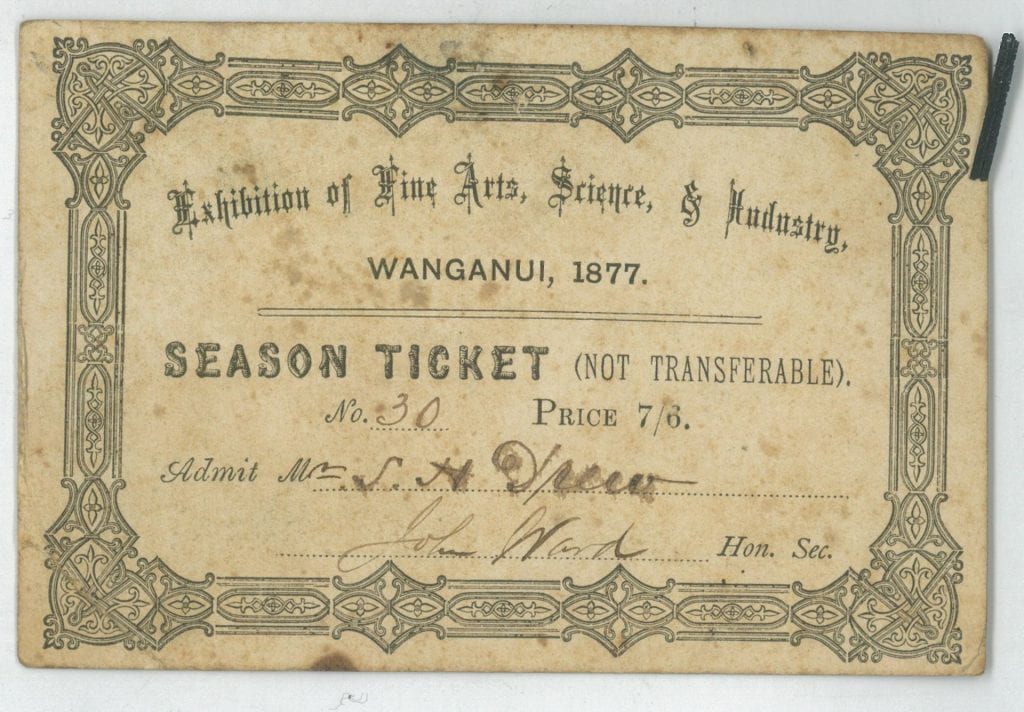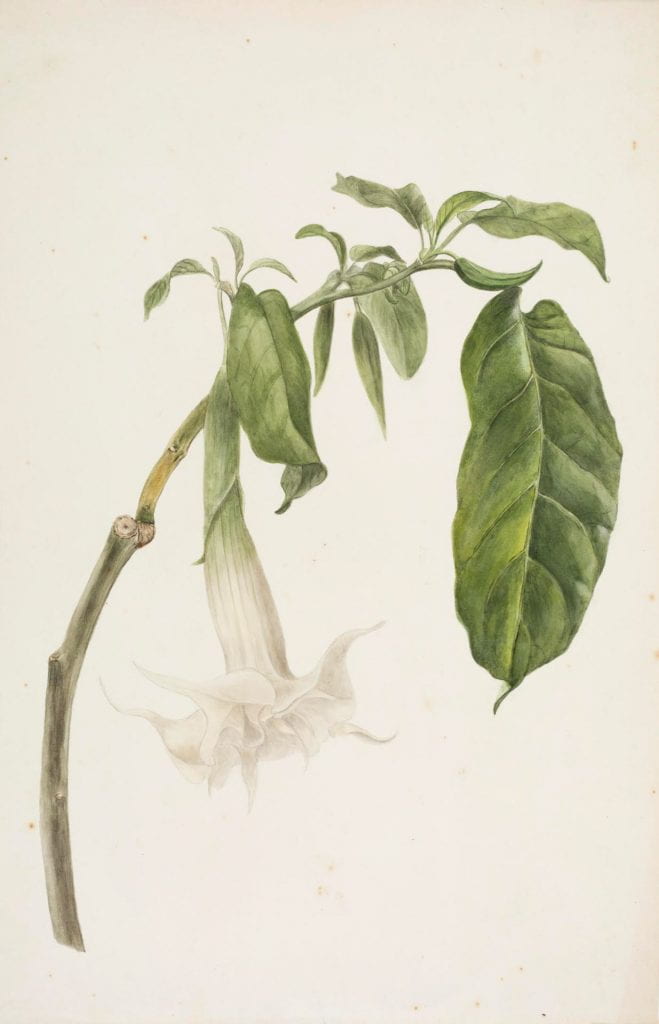By Michele Leggott

The Wanganui Chronicle reviewer offers a detailed critique of the still life and flower paintings of Mrs Hardcastle, wife of the town’s recently appointed resident magistrate:
(72) is a full sized brace of French partridges, hung against the deal lined wall of a larder. If the frame of the picture had been away, we should have thought both birds and boards were real. This picture is by Mrs Hardcastle, who also contributes one of a snipe (73), which some how or other does not appear so natural. But, talking of snipes looking natural, look at Flowers (74) and make up your mind whether the drops on them are really drops of water, or wonderful little transparencies, the effect of two or three clever touches of the artist’s brush. (23 Aug 1877: 2)
Not mentioned in the review are paintings by Emily Harris, but we know she exhibited in the exhibition because of a comment she made a couple of years later to James Hector of the colonial Museum in Wellington. Emily was at the beginning of her exhibiting career and the letter to Hector is in part a resume:
In 1873 I received a silver medal for flower painting at the Nelson Exhibition and in the same year another silver medal for the best painting of New Zealand flowers and berries at the Exhibition in Hokitika. Since that time I have exhibited at Wanganui about a year and a half ago. They did not give any prizes or medals but I have some reason to know that they liked my pictures. (25 Jan 1879. Mu000188/1/10. Te Papa Tongarewa, Wellington.)
We don’t know whether Emily knew Mrs Hardcastle or her paintings in 1877. We do know that she is a valued friend in 1885 as Emily, now a seasoned exhibitor, begins her diary with an account of how she had a private showing of the works she was about to send to Wellington for the Industrial Exhibition. Of primary importance is a new four-fold screen of native flowers painted on satin:
Tuesday afternoon I had a room full of ladies waiting to see this screen. Most of them had seen the other things, some had to go without getting a sight of it. At last Fleming came with it, I had got it into my head that it would turn out a partial failure but as soon as it was opened out in the room I saw that it would do. The ebonised frame & fretwork harmonised well with the cream satin & toned down the painting. The visitors were very much charmed & surprised. Mrs Hardcastle was a splendid show woman, pointing out everything. I was pleased that she took so much interest in it because she has exhibited her pictures in the Royal Academy in London. (7 July 1885)
Charlotte Hardcastle (1828-1908) was born in Abingdon, Berkshire, the daughter of William Hardcastle and Maria Edgington. Census results for 1841 and 1851 show the family living in Surrey. In 1861 they were living in London and Charlotte was a 32-year-old artiste; her sister Mary, also unmarried, was 42, a milliner, and their parents were 71 and 70. William Hardcastle was clerk to a merchant. In the 1850s and 1860s, Charlotte exhibited flower and bird studies at the Royal Society of British Artists, the British Institution and the Royal Academy.
Charlotte Hardcastle emigrated to Australia in July 1868. She married her cousin Edward Hardcastle (c.1836-1886) in Melbourne in August of that year. Edward had traveled to Melbourne from New Zealand to meet his bride and the couple returned to the goldfield boom town of Hokitika on the West Coast of the South Island, where Edward had been recently appointed to a law clerk position. The Hardcastles had two children: Edward Patrick Edgington Murrough, born in Hokitika in 1869 and Kathleen Charlotte Maud (or Maria), also born in Hokitika in 1872.
Is Hokitika another early connection between Charlotte Hardcastle and Emily Harris? We are trying to find out whether Charlotte exhibited at the 1873 Hokitika Exhibition. As in Whanganui, records are patchy and reviews inconclusive. We’ll keep looking.
Two months after Mrs Hardcastle’s enthusiastic promotion of the four-fold screen in 1885, Emily called on her and two other woman artist friends with a request for their company at a public meeting where Dr Julius von Haast was to speak about entries for the upcoming colonial and Indian Exhibition in London. Emily, Charlotte Hardcastle, Miss Bessie Jones and her unnamed sister were all present at von Haast’s meeting. The local paper observed the novelty of the women’s presence and Emily noted in her diary that it was the first public meeting she had ever attended. She sent six works to London. We don’t yet know whether Charlotte and the Misses Jones also sent work.
When Mrs Hardcastle makes her next appearances in Emily’s diary, she is bringing a prospective pupil and offering instruction in wood engraving:
On Monday Mrs Hardcastle brought a lady to see some of my paintings. I suppose she was much pleased for although she will only remain in Nelson about two months she wished me to give her some lessons in flower painting which I am now doing. She is to come every day that she can. (7 June 1886)
Went yesterday to Mrs Hardcastle’s & had a lesson in wood engraving. (4 July 1886)
What Emily doesn’t mention are Charlotte Hardcastle’s changed circumstances. Edward and Charlotte Hardcastle and their two children moved to Nelson in 1884 after Edward, now a Wellington district judge, was forced by illness to take leave from the bench. Judge Hardcastle died at his residence in Nile St 10 January 1886, aged 49. His death certificate notes cause of death as Tabes dorsalis, a degenerative condition of the spinal nerves due to untreated syphilis. It is unlikely that Emily or her Nelson contemporaries knew the exact cause of Edward Hardcastle’s death, but Charlotte’s widowhood must have been a peculiarly painful experience. The next time we sight her in Emily’s diary, she is preparing to leave Nelson:
Went to see Mrs Hardcastle, to see if she would give me a little more instruction in wood engraving. I am sorry to say she is going away at Christmas. She said, ‘I was thinking of you today as I packed up the engraving tools,’ but when I told her what I came for she at once said she would unpack them. So I went on Tuesday evening & again on Thursday evening when we printed off an initial letter, the first time I have ever seen anything of the kind done. (15 Nov 1886)
Charlotte Hardcastle exits the diary at this point. Her name remains on Nelson directories 1887-188, so perhaps she didn’t leave the city as precipitately as Emily imagined. Her son Edward went on to get a first-class MA in mathematics from Canterbury College, Christchurch, in 1892. He was in Wellington in 1895 and shortly afterwards moved to Cincinatti, Ohio. where he married and continued a successful career in life insurance. Our next sighting of Charlotte and Kathleen is 1896-1900 when both are registered on electoral rolls for Christchurch. By 1902 mother and daughter had returned to Whanganui and established themselves at an address in Campbell St. After Charlotte’s death in 1908, Kathleen lived on in Whanganui and by the terms of her will a fund for women in reduced circumstances was founded in 1932. The Charlotte Hardcastle Trust supported gentlewomen who were over 50 years of age and had been living in the area for five years or longer. Kathleen’s will also stipulated that an unspecified number of her mother’s paintings were to be sent to her brother in the United States.
Did Charlotte Hardcastle paint during her long residence in New Zealand? She was still a practising artist in Nelson in the mid-1880s if Emily’s tuition in wood engraving is anything to go by. Her talent is evident in the six botanical watercolour studies now in the collection of the Sarjeant Gallery in Whanganui. The paintings are undated and their provenance is uncertain, but it seems possible that they were donated to the gallery by Kathleen Hardcastle. Given Emily Harris’s admiration of Charlotte in 1885, it is easy to imagine a reciprocal showing of paintings in the drawing room of the Hardcastles’ home a few steps from the Harrises in Nile St. Perhaps Emily saw one or more of the Sarjeant watercolours there.

Update: In exciting conjunction with this research, the Whanganui Chronicle and the Sarjeant Gallery have published an article on Charlotte Hardcastle and her artwork is featured in a highlight collection in the Sarjeant Gallery.
Lead writer: Michele Leggott
Research support: Brianna Vincent, Makyla Curtis, Dasha Zapisetskaya